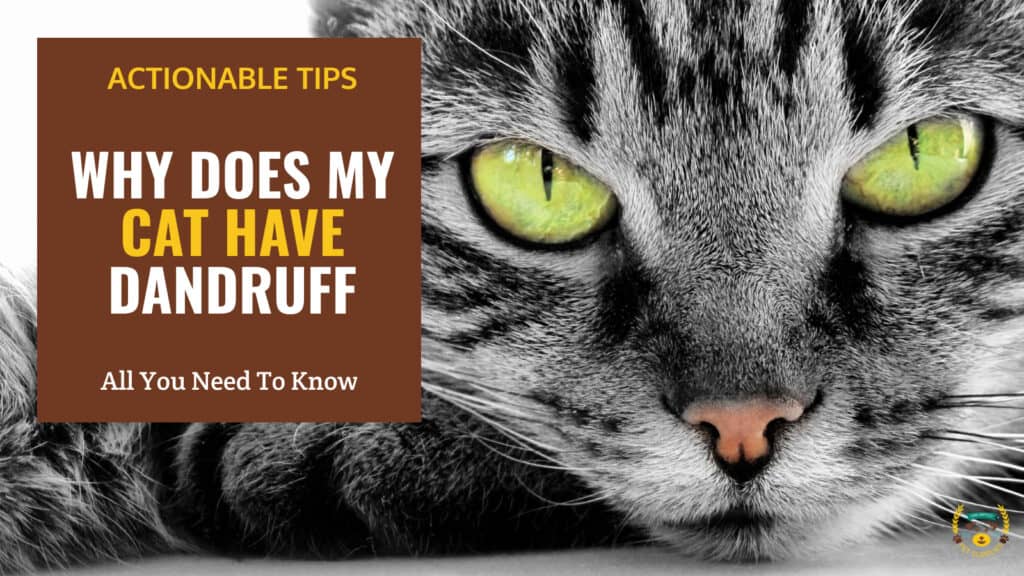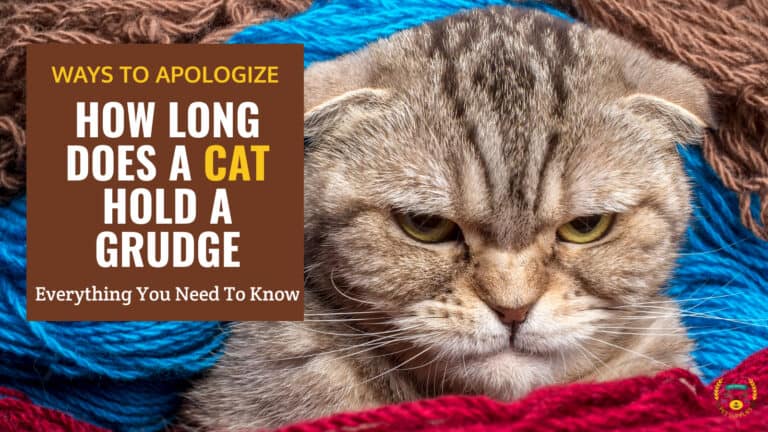Why Does My Cat Have Dandruff and How Can I Get Rid of It?
Last updated: April 1, 2024

Summary
- Cat dandruff can arise from dry skin, allergies, parasites, or fungi.
- Symptoms include white flakes, itching, and potentially hair loss or skin lesions.
- Veterinarians diagnose through examinations and tests to tailor treatment.
- Treatment options include medicated shampoos, dietary adjustments, and home environment changes.
- Dandruff isn't contagious, but its causes might be; avoid human shampoos on cats.
- Wet food helps with hydration and can decrease dandruff.
- Early veterinary intervention is crucial for effective management.
Have you noticed your feline companion leaving traces of white flakes on your furniture lately?
As unsightly as it may seem, dandruff in cats is quite common and usually harmless. However, ignoring those pesky flakes for too long can lead to painful skin irritation for the kitty.
In this brief yet insightful article, we’ll learn about the leading causes of dandruff in cats and actionable tips for properly diagnosing and treating this condition. We will provide the most effective methods for banishing dandruff flakes from your cat’s fur, from dietary changes to strategic grooming.
Say goodbye to embarrassed apologies to guests about that dander on the couch - your feline friend will be flake-free in no time.
Understanding Feline Dandruff

Feline dandruff, characterized by dry flaky skin and coat, is a common condition in cats. Getting to the root cause of skin irritation and inflammation is key to properly treating and preventing recurring cat dandruff.
Causes of Cat Dandruff
There are several underlying culprits that can trigger flaky, irritated skin in cats:
- Excessive Dryness: With grooming habits, cats may struggle to produce enough skin oils. Lack of moisture allows dead skin cells to build up.
- Allergies: Food ingredients or environmental factors like dust mites can cause allergic skin reactions in some felines.
- Parasites: Skin mites like cheyletiella can burrow and feed on skin debris.
- Fungal/Yeast: Ringworm fungal spores can infect the skin and coat and cause feline dandruff.
Pinpointing the trigger factor through vet exams allows for targeting the appropriate treatment.
Symptoms and Effects
Cat dandruff symptoms to watch for include the following:
- Visible flaky, scaly debris in the fur
- Intense scratching and skin irritation
- Patchy hair loss in severe cases
- Red lesions, scabs or skin infections
While dandruff may seem purely cosmetic, the inflammation can cause discomfort, further skin damage and hair loss impacting skin health over time. Catching the signs early allows for better management.
Diagnosing the Cause of Dandruff
Determining the underlying trigger causing a cat’s dandruff allows veterinarians to prescribe targeted treatment plans for relief and prevention.
Veterinary Diagnostic Steps

To get to the root cause of flaky skin, vets will undertake:
- Medical History: Review of any changes to food, environment, or symptoms noticed. Getting a detailed history helps vets know what to look for.
- Skin Exams: Hands-on inspection of lesions, parasites, infections, or abnormalities. The visual exam gives vets clues about the condition.
- Skin Scrapings: Microscope analysis of debris samples for fungal spores or mites helps Identify the specific parasites causing the issue.
- Blood Tests: Check for elevated allergy antibody levels to environ/food. This can help pinpoint possible allergy triggers.
Testing allows vets to definitively diagnose the dandruff trigger in most cats.
Most Common Causes
The top specific causes of irritated feline skin frequently diagnosed are:
- Food Allergies: Particularly to common proteins like beef, dairy or fish. Following elimination diets helps confirm the allergies.
- Environmental Factors: Dust mites, cigarette smoke and chemicals irritate the skin. Reducing exposure to these elements will improve skin health in such conditions.
- Parasitic Mites: Cheyletiella mites burrow and feed on dead skin. Using topical treatments kills the mites.
- Fungal Infection: Ringworm, a highly contagious fungus, spreads spores. Antifungal medicine can help treat the infection.
Pinpointing one of these common factors then guides suitable treatments.
When to Visit the Vet
See your vet promptly if your cat shows any of the following signs:
- Significant fur loss or bald spots. This could signal a serious skin condition.
- Oozing sores or scaly skin lesions. They indicate a possible infection.
- No improvement after a month of OTC anti-dandruff products. In this case, prescription remedies may be required.
Catching issues early, identifying underlying conditions, and accurately diagnosing the trigger promotes faster healing and relief for cats with dandruff.
Treating and Preventing Cat Dandruff
Effective treatment and prevention of cat dandruff involve a multi-faceted approach that addresses both the immediate condition and its underlying causes.

Shampoos and Sprays
A cornerstone of managing feline dandruff is topical therapy. Some proven effective solutions include:
Colloidal Oatmeal Shampoos
These shampoos are not only soothing but also help in hydrating dry skin and relieving itchiness and flaking associated with dandruff. A good example is Petway's Cat Shampoo.
Antifungal and Anti-parasitic Rinses
In cases where dandruff is due to fungal or parasitic infections, medicated rinses such as Veterinary Formula's can be an effective part of the treatment protocol.
Moisturizing Leave-in Conditioners

Continuous hydration can be achieved with the use of leave-in conditioners specially formulated for feline skin, which help to lock in moisture and reinforce the skin barrier.
Integrating these products into your cat’s grooming routine can significantly manage and reduce dandruff.
To ensure your furry companion receives the gentlest care during bath time, it's essential to select a good shampoo. The right cat shampoo can promote a radiant coat, alleviate skin sensitivities, and make your cat feel pampered and loved.
Nutrition and Supplements
Targeting dandruff from the inside out, nutrition plays a pivotal role. Opt for the following remedies:
Limited Ingredient Diets (LID)
LIDs can help in ruling out and managing food allergies, which are a common culprit behind skin issues. To further understand the impact of diet on your cat's health, consider exploring proper cat feeding timelines.
Omega Fatty Acid Supplements
A balanced intake of omega-3 and omega-6 fatty acids is vital for maintaining healthy skin and coat. These supplements can reduce inflammation and promote a healthier skin barrier.
Antioxidants
Vitamin E supplements can support skin health due to their potent antioxidant properties that help in combating oxidative stress.
Implementing these dietary changes can support skin health and contribute to the resolution of dandruff.
Environmental Modifications

Last but not least, changing your home environment can have a positive impact:
- Air Quality: Reducing airborne irritants such as smoke, dust, and aerosol sprays can alleviate skin irritation and subsequent flaking.
- Regular Grooming: Using a soft bristle brush helps in the regular removal of dandruff flakes and distributes skin oils along the fur to naturally moisturize the coat.
- Humidity Control: Dry air can exacerbate skin dryness. Using a humidifier to maintain adequate indoor humidity levels can help keep your cat's skin hydrated.
By tailoring the environment to the needs of your feline friend, you can further reduce the likelihood of dandruff recurring.
An integrated approach combining the right skincare products, optimal nutrition, and a conducive home environment will yield the best results in treating and preventing cat dandruff.
Frequently Asked Questions
We provided answers to the most widely asked questions related to cat dandruff to ensure you get as much information as possible about the topic.
Is Cat Dandruff Contagious to Other Pets?
Dandruff itself is not contagious. However, the underlying causes such as mites or fungal infections can spread to other pets. It's crucial to identify the root cause to ensure proper treatment and prevent transmission.
Can I Use Human Anti-Dandruff Shampoo on My Cat?
No, human anti-dandruff shampoos can be harmful to cats. They often contain ingredients like zinc pyrithione or selenium sulfide, which can be toxic if ingested during grooming. Always use products specifically designed for feline skin.
What Home Remedies Help with Cat Dandruff?
Several home remedies may alleviate cat dandruff:
- Natural Oils: Gently massaging olive oil or coconut oil into your cat's skin can moisturize dry skin and reduce flaking.
- Aloe Vera Gel: Known for its soothing properties, aloe vera can calm irritated skin when applied in small amounts.
- Regular Brushing: Regularly brushing your cat with a soft-bristle brush helps distribute natural oils throughout the coat, keeping skin hydrated.
Implementing these remedies can support your cat's skin health, but should not replace veterinary advice if symptoms persist.
Is cat dandruff harmful to humans?
Yes, Cheyletiella mites can infect people, even if humans are not natural hosts to these mites. Still, the infection and skin rash caused by the mites in humans typically only last around a few weeks.
Does wet food help cat dandruff?
Yes, feeding cats wet food can help mitigate dandruff issues by ensuring adequate hydration. Many cats do not drink enough water on their own throughout the day.
Wet foods provide supplemental hydration, which supports skin and coat health.
Final Thoughts
While feline dandruff can be a nuisance, it is often manageable with the right care and diligence. Understanding the condition, providing appropriate care at home, and seeking veterinary advice when needed will ensure the well-being of your cherished feline companion.
If you have any questions or comments, please contact us. We will do our best to assist you and your feline companion the best we can.






